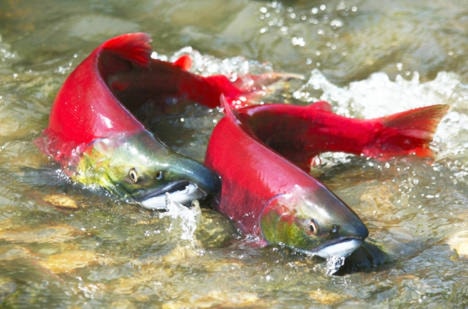As forecasts for this year’s sockeye and chinook returns worsen, Fisheries and Oceans is advising stakeholders and businesses to plan ahead for a season possibly worse than 2017.
As expected, projections for sockeye look similar to last year, currently at about 520,000, roughly 300,000 short for opening the recreational fishery.
For First Nations’ food, ceremonial and social harvesting the target is 400,000. However, as DFO develops a harvest plan for the Skeena watershed and the North Coast, First Nations Technical Committees are recommending a ban on sockeye unless indicators push the numbers above 600,000.
Last year DFO supported a First Nations proposal to redirect some of the demand for food and ceremonial sockeye onto the chinook stock, but it’s also doubtful that will occur for 2018 as the chinook estimates are also among the lowest on record.
“It’s certainly one of the most challenging seasons we’ve faced on the North Coast in recent—or our full history,” said Colin Masson, North Coast director for DFO.
“We are extremely concerned about the situation this year, because we’re looking at starting the sockeye season with no harvest for food, social and ceremonial purposes.
“But we’re really concerned about chinook stocks—not just small spawning populations that were closed last year. We’re thinking, we’re proposing, we might have to start the season with…chinook retention in the Skeena watershed.”
Following a key meeting March 8 with the Integrated Harvest Planning Committee, Masson said these options are just a starting point for discussions, but they may result in even stronger measures, not limited to a closure of the commercial marine fishery for Skeena-bound chinook, as well as a reduction in the marine recreational fishery.
“One of the really important points here is this isn’t just about Skeena-bound chinook. This is an issue that southeast Alaska is facing with their chinook stocks, it’s a North Coast chinook-stock issue, it’s a Central Coast chinook-stock issue, and many of the Fraser-bound chinook stocks are all in the same situation of low productivity.”
This is due in part, he said, to the chinook’s compromised marine environment over the past several years, including the effects of the so-called blob, a huge mass of warm water off the Pacific coast that severely disrupted the local marine ecosystem. It dissipated in late 2016 but its impact on the multi-year cycles of salmon populations is still active.
Richard Sparrow is the natural resources manager for the First Nations Fisheries Council of B.C., who advises a group of technicians who work with many First Nations communities along the Skeena River. During the sockeye closures last year, Sparrow said First Nations took additional steps to protect salmon.
“First Nations are really taking the bull by the horns here in identifying management plans and fishery plans that have conservation in mind,” Sparrow said. One example he offered was using 18 cm or larger mesh size gillnetts to allow sockeye to go through with a small by catch of sockeye.
In addition to a complete closure of the sockeye fishery last year, the DFO shut down recreational and sport fishing of all other species for one month ending July 14. The business community, particularly in the tourism sector, railed against DFO for what they saw as an excessive response to low counts, and for giving the sector no time to adjust their operations for the imminent loss of business.
A 2008 study published by the Pacific Salmon Foundation pegged the direct economic impact of the Skeena salmon sport and recreational industry at $34 million, plus another $19 million indirectly.
This year Masson says his intention is to warn businesses as early as possible of the situation.
“While no decisions have been made, we’re looking at a situation that is bad or worse than last year. We’re working to expedite decisions, but a lot of that is beyond our control. People should be seriously considering how they plan their businesses associated with recreational fishing, because they may be significantly impacted this year.”
In the midst of the planning process, Masson says there has been strong collaboration with First Nations groups on the technical planning of both the marine fishery and the Skeena watershed. DFO will be following up with each group on their recommendations, in addition to furthering conversations with Sports Fish Advisory Committees, before finalizing a plan likely in early May.
“All of the organizations and all of the Indigenous groups are working with the department and recognizing the challenges we’re facing. We’re looking to see where we can go with this, and how we can balance interests, but our fundamental priority is conservation. That’s our absolute priority.”
- with files from Shannon Lough
